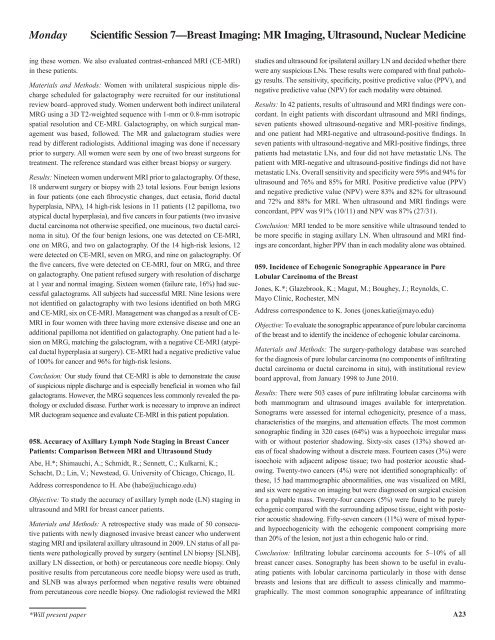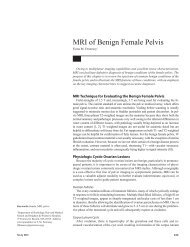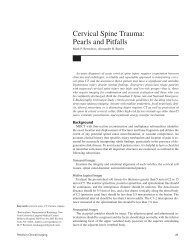Scientific Session 1 â Breast Imaging: Mammography
Scientific Session 1 â Breast Imaging: Mammography
Scientific Session 1 â Breast Imaging: Mammography
Create successful ePaper yourself
Turn your PDF publications into a flip-book with our unique Google optimized e-Paper software.
Monday<strong>Scientific</strong> <strong>Session</strong> 7—<strong>Breast</strong> <strong>Imaging</strong>: MR <strong>Imaging</strong>, Ultrasound, Nuclear Medicineing these women. We also evaluated contrast-enhanced MRI (CE-MRI)in these patients.Materials and Methods: Women with unilateral suspicious nipple dischargescheduled for galactography were recruited for our institutionalreview board–approved study. Women underwent both indirect unilateralMRG using a 3D T2-weighted sequence with 1-mm or 0.8-mm isotropicspatial resolution and CE-MRI. Galactography, on which surgical managementwas based, followed. The MR and galactogram studies wereread by different radiologists. Additional imaging was done if necessaryprior to surgery. All women were seen by one of two breast surgeons fortreatment. The reference standard was either breast biopsy or surgery.Results: Nineteen women underwent MRI prior to galactography. Of these,18 underwent surgery or biopsy with 23 total lesions. Four benign lesionsin four patients (one each fibrocystic changes, duct ectasia, florid ductalhyperplasia, NPA), 14 high-risk lesions in 11 patients (12 papilloma, twoatypical ductal hyperplasia), and five cancers in four patients (two invasiveductal carcinoma not otherwise specified, one mucinous, two ductal carcinomain situ). Of the four benign lesions, one was detected on CE-MRI,one on MRG, and two on galactography. Of the 14 high-risk lesions, 12were detected on CE-MRI, seven on MRG, and nine on galactography. Ofthe five cancers, five were detected on CE-MRI, four on MRG, and threeon galactography. One patient refused surgery with resolution of dischargeat 1 year and normal imaging. Sixteen women (failure rate, 16%) had successfulgalactograms. All subjects had successful MRI. Nine lesions werenot identified on galactography with two lesions identified on both MRGand CE-MRI, six on CE-MRI. Management was changed as a result of CE-MRI in four women with three having more extensive disease and one anadditional papilloma not identified on galactography. One patient had a lesionon MRG, matching the galactogram, with a negative CE-MRI (atypicalductal hyperplasia at surgery). CE-MRI had a negative predictive valueof 100% for cancer and 96% for high-risk lesions.Conclusion: Our study found that CE-MRI is able to demonstrate the causeof suspicious nipple discharge and is especially beneficial in women who failgalactograms. However, the MRG sequences less commonly revealed the pathologyor excluded disease. Further work is necessary to improve an indirectMR ductogram sequence and evaluate CE-MRI in this patient population.058. Accuracy of Axillary Lymph Node Staging in <strong>Breast</strong> CancerPatients: Comparison Between MRI and Ultrasound StudyAbe, H.*; Shimauchi, A.; Schmidt, R.; Sennett, C.; Kulkarni, K.;Schacht, D.; Lin, V.; Newstead, G. University of Chicago, Chicago, ILAddress correspondence to H. Abe (habe@uchicago.edu)Objective: To study the accuracy of axillary lymph node (LN) staging inultrasound and MRI for breast cancer patients.Materials and Methods: A retrospective study was made of 50 consecutivepatients with newly diagnosed invasive breast cancer who underwentstaging MRI and ipsilateral axillary ultrasound in 2009. LN status of all patientswere pathologically proved by surgery (sentinel LN biopsy [SLNB],axillary LN dissection, or both) or percutaneous core needle biopsy. Onlypositive results from percutaneous core needle biopsy were used as truth,and SLNB was always performed when negative results were obtainedfrom percutaneous core needle biopsy. One radiologist reviewed the MRIstudies and ultrasound for ipsilateral axillary LN and decided whether therewere any suspicious LNs. These results were compared with final pathologyresults. The sensitivity, specificity, positive predictive value (PPV), andnegative predictive value (NPV) for each modality were obtained.Results: In 42 patients, results of ultrasound and MRI findings were concordant.In eight patients with discordant ultrasound and MRI findings,seven patients showed ultrasound-negative and MRI-positive findings,and one patient had MRI-negative and ultrasound-positive findings. Inseven patients with ultrasound-negative and MRI-positive findings, threepatients had metastatic LNs, and four did not have metastatic LNs. Thepatient with MRI-negative and ultrasound-positive findings did not havemetastatic LNs. Overall sensitivity and specificity were 59% and 94% forultrasound and 76% and 85% for MRI. Positive predictive value (PPV)and negative predictive value (NPV) were 83% and 82% for ultrasoundand 72% and 88% for MRI. When ultrasound and MRI findings wereconcordant, PPV was 91% (10/11) and NPV was 87% (27/31).Conclusion: MRI tended to be more sensitive while ultrasound tended tobe more specific in staging axillary LN. When ultrasound and MRI findingsare concordant, higher PPV than in each modality alone was obtained.059. Incidence of Echogenic Sonographic Appearance in PureLobular Carcinoma of the <strong>Breast</strong>Jones, K.*; Glazebrook, K.; Magut, M.; Boughey, J.; Reynolds, C.Mayo Clinic, Rochester, MNAddress correspondence to K. Jones (jones.katie@mayo.edu)Objective: To evaluate the sonographic appearance of pure lobular carcinomaof the breast and to identify the incidence of echogenic lobular carcinoma.Materials and Methods: The surgery-pathology database was searchedfor the diagnosis of pure lobular carcinoma (no components of infiltratingductal carcinoma or ductal carcinoma in situ), with institutional reviewboard approval, from January 1998 to June 2010.Results: There were 503 cases of pure infiltrating lobular carcinoma withboth mammogram and ultrasound images available for interpretation.Sonograms were assessed for internal echogenicity, presence of a mass,characteristics of the margins, and attenuation effects. The most commonsonographic finding in 320 cases (64%) was a hypoechoic irregular masswith or without posterior shadowing. Sixty-six cases (13%) showed areasof focal shadowing without a discrete mass. Fourteen cases (3%) wereisoechoic with adjacent adipose tissue; two had posterior acoustic shadowing.Twenty-two cancers (4%) were not identified sonographically: ofthese, 15 had mammographic abnormalities, one was visualized on MRI,and six were negative on imaging but were diagnosed on surgical excisionfor a palpable mass. Twenty-four cancers (5%) were found to be purelyechogenic compared with the surrounding adipose tissue, eight with posterioracoustic shadowing. Fifty-seven cancers (11%) were of mixed hyperandhypoechogenicity with the echogenic component comprising morethan 20% of the lesion, not just a thin echogenic halo or rind.Conclusion: Infiltrating lobular carcinoma accounts for 5–10% of allbreast cancer cases. Sonography has been shown to be useful in evaluatingpatients with lobular carcinoma particularly in those with densebreasts and lesions that are difficult to assess clinically and mammographically.The most common sonographic appearance of infiltrating*Will present paperA23
















